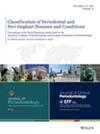Association between missing teeth number and all-cause and cardiovascular mortality: NHANES 1999–2004 and 2009–2014
Abstract
Background
The association between tooth loss and all-cause and cardiovascular mortality requires further investigation.
Methods
This study included 17993 participants from the National Health and Nutrition Examination Surveys (NHANES) 1999–2004 and 2009–2014. Weighted multivariable Cox proportional hazard models were used to assess the association between tooth loss and all-cause and cardiovascular mortality. Restricted cubic splines (RCS) were incorporated in the models to explore potential nonlinear relationships.
Results
Over a median follow-up of 116 months, 2152 participants died, including 625 cardiovascular deaths. Compared to participants without missing teeth, participants with 11–19 missing teeth had the highest risk of all-cause mortality (hazard ratio [HR] 1.89, 95% confidence interval [CI] 1.43–2.51), while participants with 6–10 missing teeth had the highest risk of cardiovascular mortality (HR 2.51, 95% CI 1.68–3.76). RCS analyses revealed nonlinear associations between number of missing teeth and all-cause (p < 0.001) and cardiovascular (p = 0.001) mortality. With < 10 missing teeth, each additional missing tooth increased all-cause and cardiovascular mortality by 6% (HR 1.06, 95% CI 1.03–1.09) and 9% (HR 1.09, 95% CI 1.03–1.15), respectively. However, when the number of missing teeth was ≥10, the risk of mortality did not continue to increase with more missing teeth. A significant interaction was found between tooth loss and age (p < 0.001 for both outcomes).
Conclusion
We observed an inverted L-shaped association between tooth loss and mortality, wherein risks increased with more missing teeth until 10, but did not continue increasing thereafter. The association was stronger in adults < 65 years old.


 求助内容:
求助内容: 应助结果提醒方式:
应助结果提醒方式:


